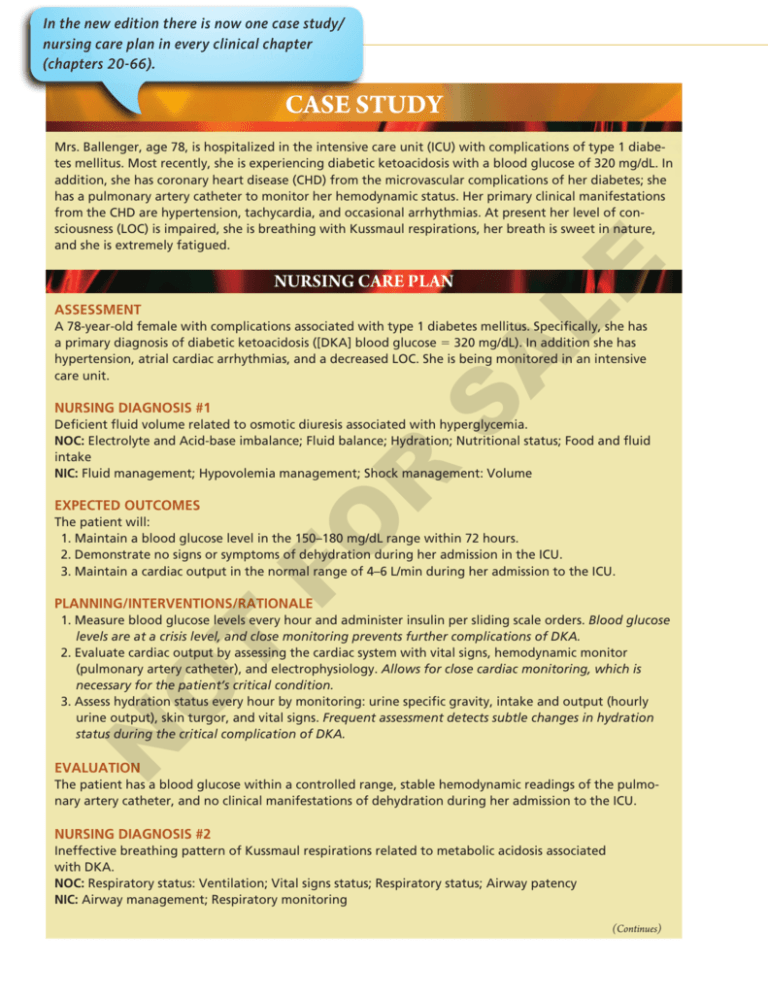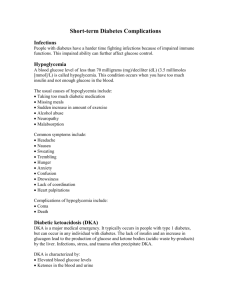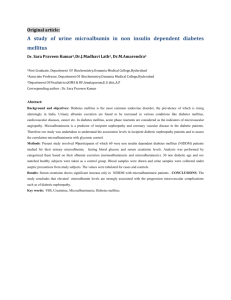CASE STUDY
advertisement

In the new edition there is now one case study/ nursing care plan in every clinical chapter 57-24 UNIT 13 Alterations in Endocrine Function (chapters 20-66). CASE STUDY NURSING CARE PLAN ASSESSMENT LE Mrs. Ballenger, age 78, is hospitalized in the intensive care unit (ICU) with complications of type 1 diabetes mellitus. Most recently, she is experiencing diabetic ketoacidosis with a blood glucose of 320 mg/dL. In addition, she has coronary heart disease (CHD) from the microvascular complications of her diabetes; she has a pulmonary artery catheter to monitor her hemodynamic status. Her primary clinical manifestations from the CHD are hypertension, tachycardia, and occasional arrhythmias. At present her level of consciousness (LOC) is impaired, she is breathing with Kussmaul respirations, her breath is sweet in nature, and she is extremely fatigued. A A 78-year-old female with complications associated with type 1 diabetes mellitus. Specifically, she has a primary diagnosis of diabetic ketoacidosis ([DKA] blood glucose = 320 mg/dL). In addition she has hypertension, atrial cardiac arrhythmias, and a decreased LOC. She is being monitored in an intensive care unit. S NURSING DIAGNOSIS #1 R Deficient fluid volume related to osmotic diuresis associated with hyperglycemia. NOC: Electrolyte and Acid-base imbalance; Fluid balance; Hydration; Nutritional status; Food and fluid intake NIC: Fluid management; Hypovolemia management; Shock management: Volume EXPECTED OUTCOMES FO The patient will: 1. Maintain a blood glucose level in the 150–180 mg/dL range within 72 hours. 2. Demonstrate no signs or symptoms of dehydration during her admission in the ICU. 3. Maintain a cardiac output in the normal range of 4–6 L/min during her admission to the ICU. PLANNING/INTERVENTIONS/RATIONALE N O T 1. Measure blood glucose levels every hour and administer insulin per sliding scale orders. Blood glucose levels are at a crisis level, and close monitoring prevents further complications of DKA. 2. Evaluate cardiac output by assessing the cardiac system with vital signs, hemodynamic monitor (pulmonary artery catheter), and electrophysiology. Allows for close cardiac monitoring, which is necessary for the patient’s critical condition. 3. Assess hydration status every hour by monitoring: urine specific gravity, intake and output (hourly urine output), skin turgor, and vital signs. Frequent assessment detects subtle changes in hydration status during the critical complication of DKA. EVALUATION The patient has a blood glucose within a controlled range, stable hemodynamic readings of the pulmonary artery catheter, and no clinical manifestations of dehydration during her admission to the ICU. NURSING DIAGNOSIS #2 Ineffective breathing pattern of Kussmaul respirations related to metabolic acidosis associated with DKA. NOC: Respiratory status: Ventilation; Vital signs status; Respiratory status; Airway patency NIC: Airway management; Respiratory monitoring (Continues) CHAPTER 57 Diabetes Mellitus: Nursing Management 57-25 CASE STUDY (Continued) EXPECTED OUTCOMES The patient will: 1. Demonstrate an effective respiratory rate of 12–16 breaths per minute with an oxygen saturation level of at least 94% within 24 hours. 2. Progressively regain level of consciousness within 24 to 48 hours. 3. Decrease energy expenditures and experience less generalized fatigue within 24 to 48 hours. LE PLANNING/INTERVENTIONS/RATIONALE A 1. Monitor oxygen saturation levels and assess depth or rhythm of respirations every hour. Detects respiratory compensation during a time of the respiratory crisis of Kussmaul breathing (caused by the DKA). 2. Assess LOC by evaluating neurological responses and patient’s ability to effectively answer questions every hour. Provides constant monitoring of neurological status. 3. Ask patient questions regarding her level of energy and ask patient to quantify from 1–10 the level of her fatigue every hour. Evaluates fatigue levels on constant basis. S EVALUATION R The patient has a progressive decrease in the Kussmaul breathing pattern, an increasing LOC, and an increasing level of energy. FO SUMMARY OF KEY CONCEPTS N O T • Diabetes mellitus refers to a group of chronic disorders of metabolism characterized by elevated blood glucose levels as well as disturbances in metabolism of carbohydrate, fat, and protein. • There are four types of diabetes mellitus: type 1 diabetes mellitus, type 2 diabetes mellitus, gestational diabetes, and impaired glucose tolerance (prediabetes). • Insulin is one of the hormones produced by the pancreas (beta cells) with a function of lowering blood sugar. • Glucagon is a hormone released by the alpha cells of the pancreas, and it functions to raise blood sugar levels. • Patients with both type 1 and type 2 diabetes will present with the three Ps of diabetes (i.e., polydipsia, polyphagia, and polyuria). • Nutritional therapy is based on a well-balanced diet and is one of the mainstays in the treatment of diabetes. • Regular exercise is an essential part of the treatment of diabetes because of its ability to lower blood sugar and decrease cardiovascular risk factors. • Diabetic ketoacidosis results from a marked insulin deficiency and is manifested by hyperglycemia, ketosis, acidosis, and dehydration. • HHNS is a life-threatening emergency associated with severe hyperglycemia, an osmotic dieresis, and a profound fluid volume deficit. • Hypoglycemia is an acute complication of diabetes where the blood glucose levels are less than 70 mg/dL. • Chronic complications include macrovascular and microvascular problems. These complications include angiopathy or vessel disease, retinopathy, neuropathy, and nephropathy. • Macrovascular complications in diabetes cause changes in the large vessels. • Diabetic neuropathies involve the peripheral, autonomic, and spinal nerves. • The most common cause of hospitalization for the diabetic patient is complications of the lower extremities, specifically the foot.







